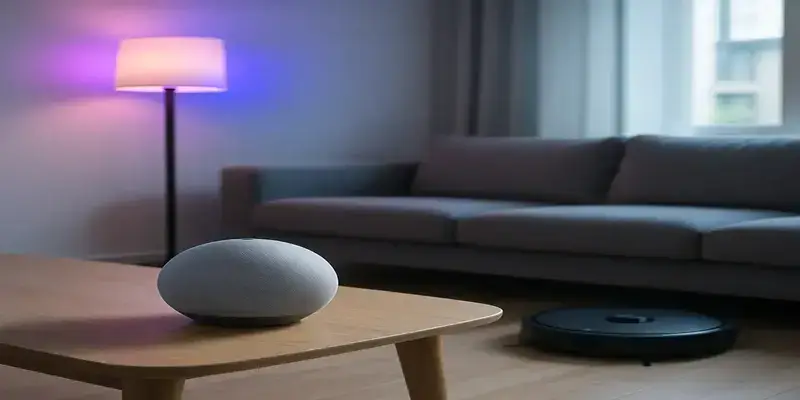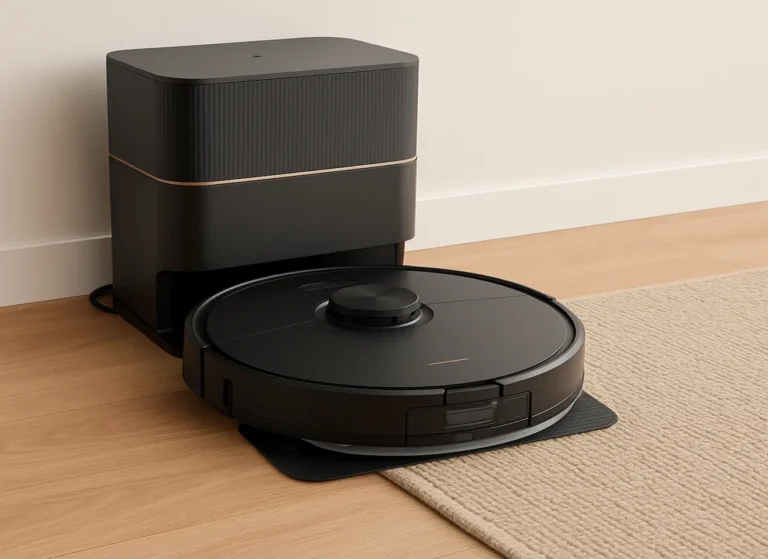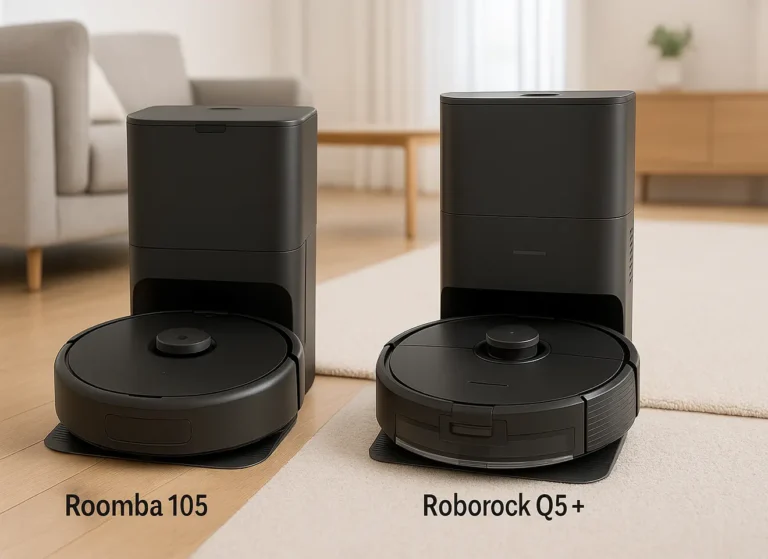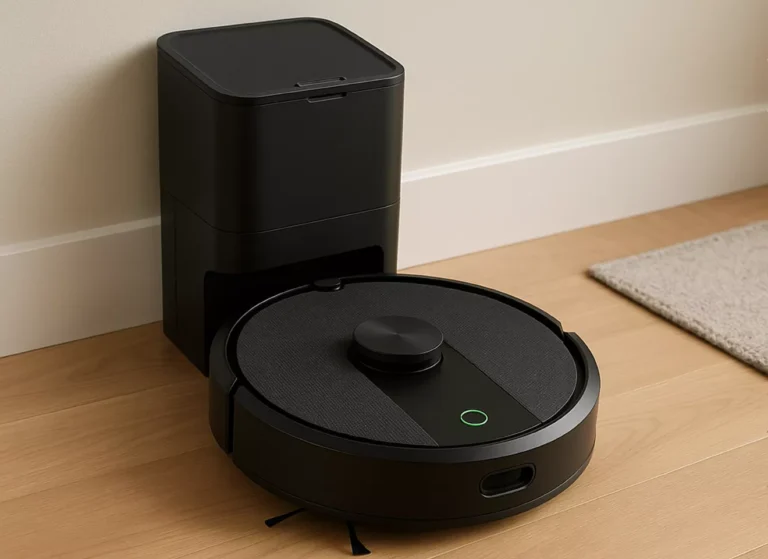What Nobody Tells You About the Kasa HS103: Renter Review (2025)
kasa hs103 review (≤250): tiny, no-hub smart plug that automates lamps/fans in rentals. Reliable app, schedules/timers/Away mode, Alexa/Google voice. Limits: 2.4 GHz only, 15A/1800W max, no HomeKit/Matter, no energy stats. Best cheap starting point for renters.
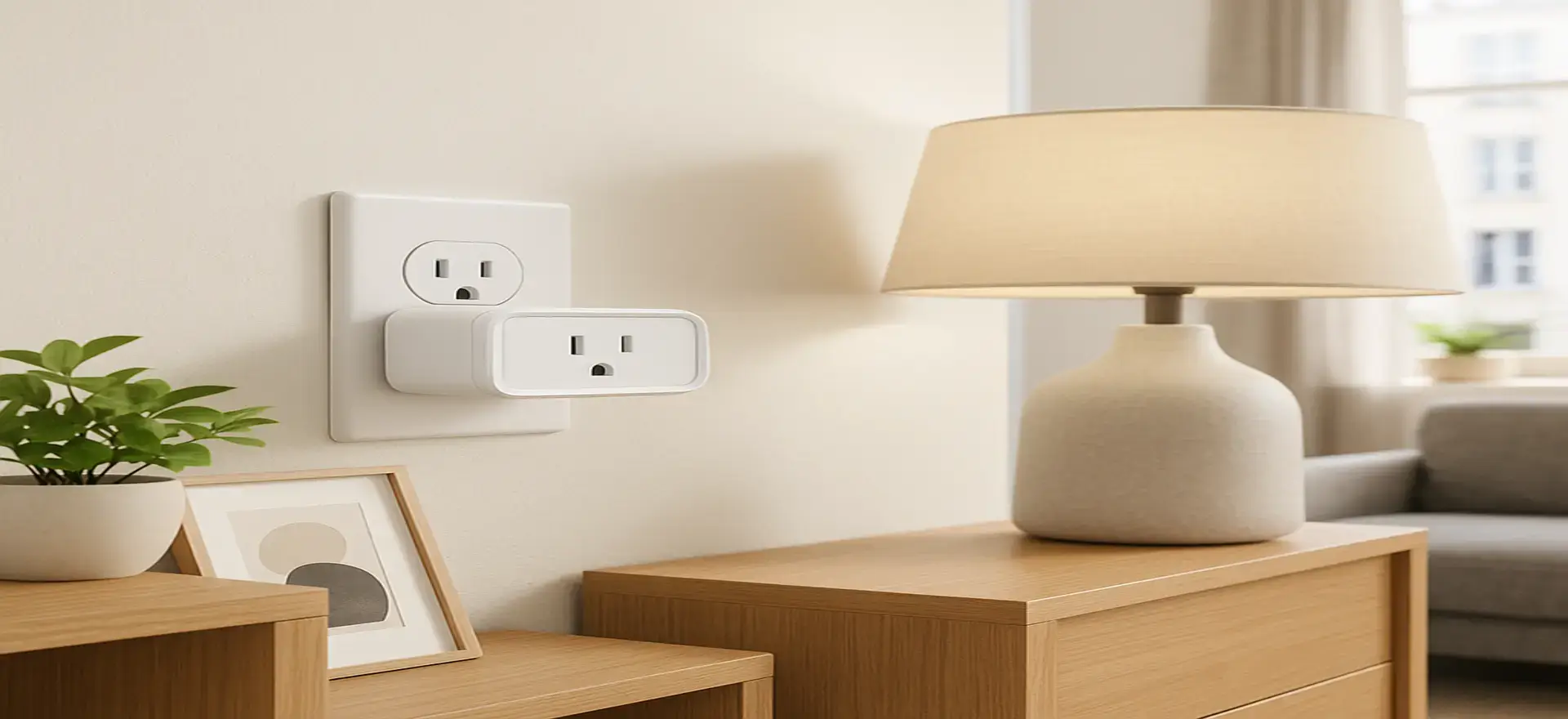
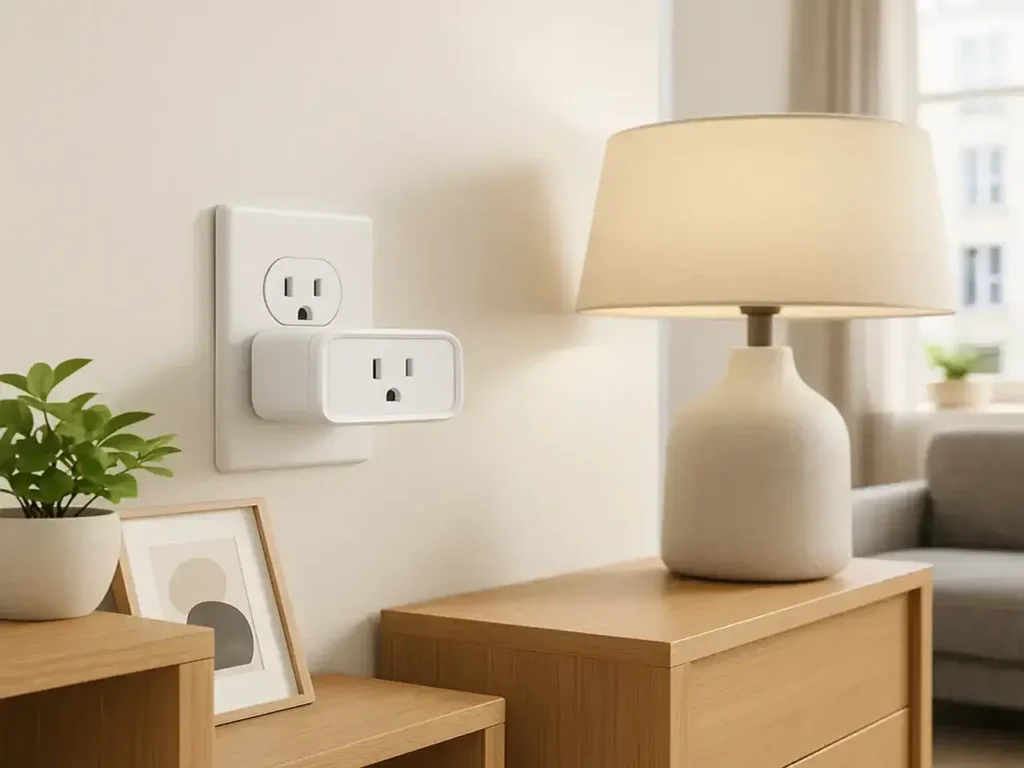
This image has been generated using AI for illustrative purposes only and does not represent an actual product image.
Getting to Know the HS103 (Renter-First)
The Kasa HS103 is the easiest “yes” in a lease. It slips between a regular outlet and something you already own—a floor lamp, a desk fan, a string of seasonal lights—and instantly adds app control, schedules, timers, and voice commands. No drilling, no wiring, no landlord conversations. In a world of hubs and bridges, this one wins by being small, fast to set up, and genuinely portable.
What follows isn’t a spec dump; it’s the kasa hs103 review renters actually need: what it changes on day one, how it behaves month to month, the limits that matter in apartments, and when to skip it for a sibling model (KP115 for energy stats or KP125M for Matter).
Quick Specs (and Why They Matter in a Lease)
Form factor: mini smart plug that usually doesn’t block the second outlet, so a vacuum or charger can still share the duplex.
Power rating: 15A / 1800W (US). Perfect for lamps, fans, and light appliances; don’t use for heavy heaters or portable AC—check the device label.
Connectivity: 2.4 GHz Wi-Fi, no hub required.
App & features: Kasa app with Schedules, Timers, Away Mode, and scenes.
Voice assistants: Amazon Alexa & Google Assistant (no Apple HomeKit on HS103).
What it doesn’t have: energy monitoring (that’s KP115), no Matter (that’s KP125M).
If you want the exact electrical ratings and safety notes from the source, the manufacturer documentation is the clean reference: official HS103 support page.
Setup in Five Renter-Friendly Steps
Plug it in where it actually matters (living-room lamp, desk fan, entry light).
Open the Kasa app → Add Device and follow the prompts.
Connect to 2.4 GHz Wi-Fi. If your phone insists on 5 GHz, stand near the router or temporarily split SSIDs so you can choose 2.4 GHz.
Name it clearly (“Entry Lamp,” “Desk Fan”). Short, unique names become effortless voice commands.
Test a voice command and add one routine you’ll feel tonight—sunset on, bedtime off.
Already using voice at home? This plug slots right into your flow—especially with an Echo. If you’re building from scratch, pair it with the guide you already have: Amazon Echo Dot for Renters (2025).
Real Apartment Scenarios (No Drills, No Drama)
Living-room ambience that behaves: the lamp switches on at sunset and off at 11 pm, so the room feels intentional without touching a wall switch.
Bedroom fan on autopilot: start white noise 30 minutes before bed; timer off at 3 am so you don’t freeze.
Entryway peace of mind: Away Mode toggles a lamp at convincing intervals in the evening while you’re out—simple occupancy mimic, zero hardware.
Seasonal lights without crawling: schedule string lights and skip the tiny in-line clicker buried behind the sofa.
WFH boundaries: a “Focus” scene powers your desk lamp at 9:00; “Done for today” turns it off at 6:00 so work doesn’t bleed into the night.
NEW – Winter dryness fix (humidifier): run a small humidifier on time windows (e.g., 7–9 am and 8–10 pm). Check the device label first; many compact units are well under the 15A limit, but verify.
NEW – Humid climate help (dehumidifier): schedule a compact dehumidifier in the afternoon when you’re out, then off at night. Use models that auto-resume after power is restored and confirm they stay within 15A.
All of this fits into a broader smart home for renters plan that’s landlord-friendly and moves with you.
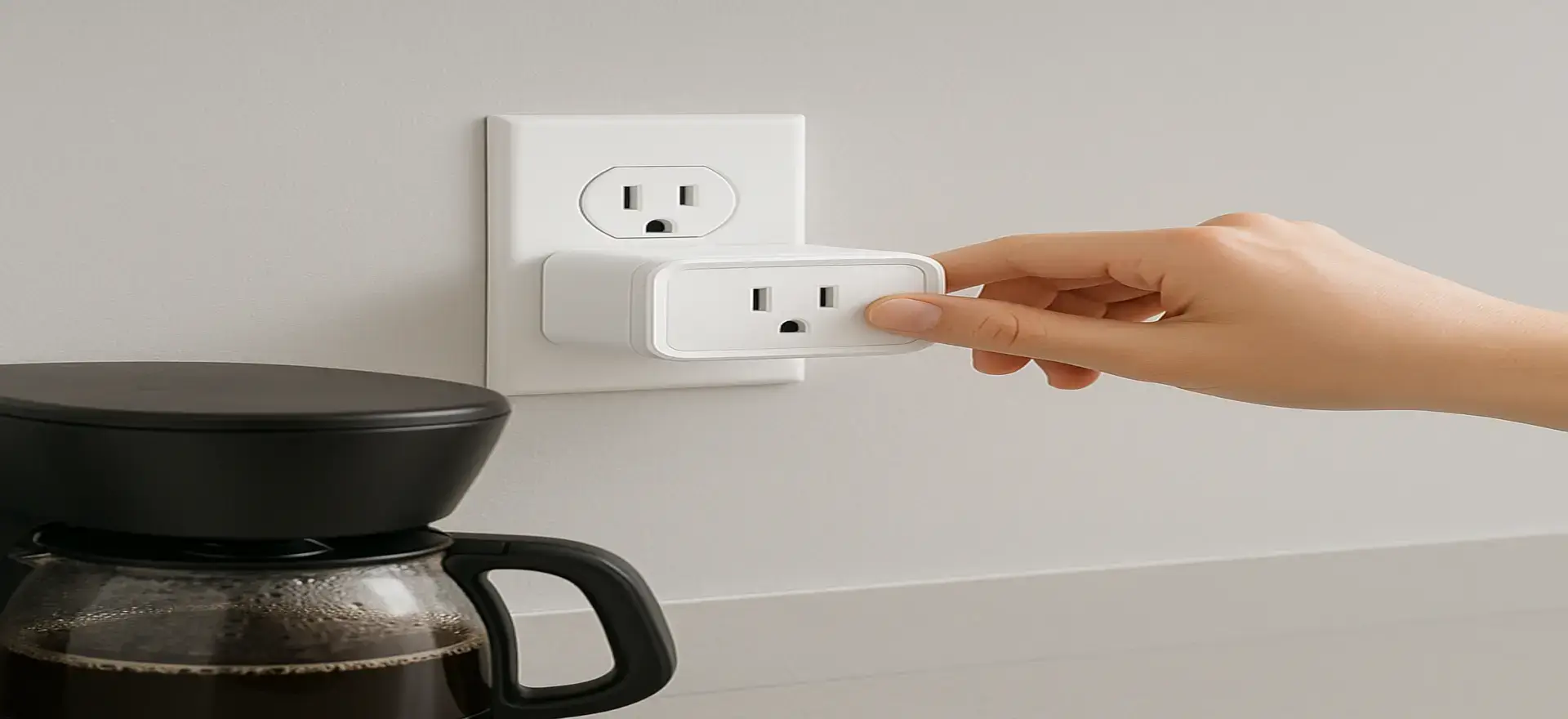
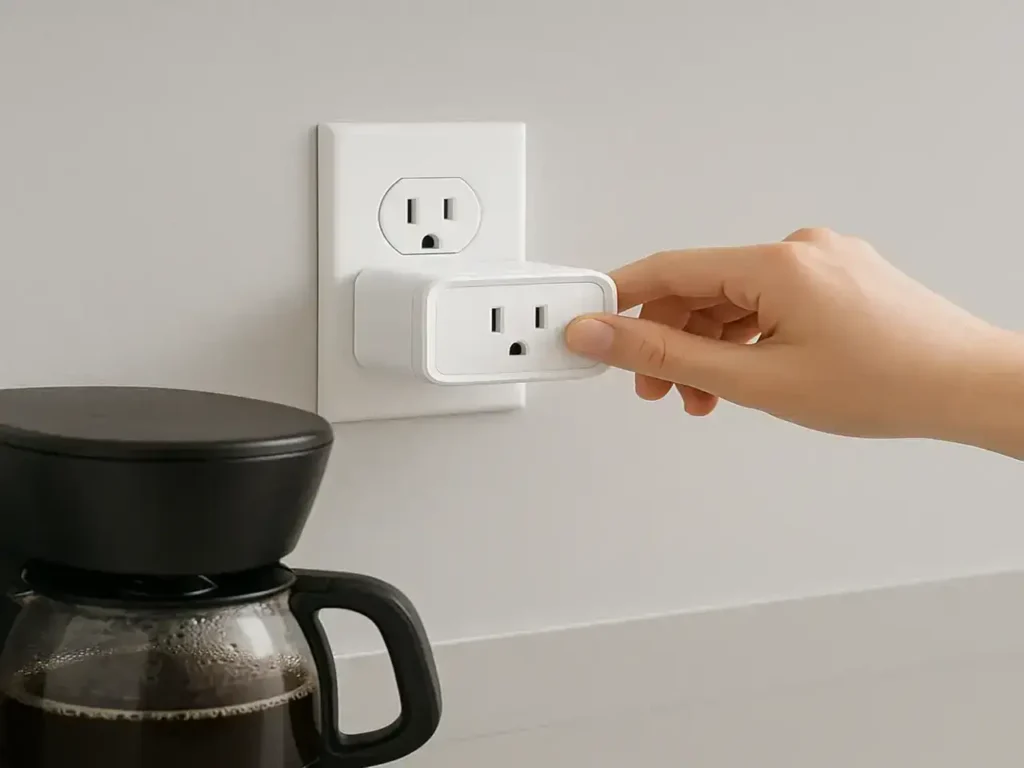
This image has been generated using AI for illustrative purposes only and does not represent an actual product image.
Automations That Actually Matter
Schedules & Timers: set the daily rhythm (weekday mornings vs. weekends, sunset vs. fixed times for basement apartments).
Away Mode: randomized on/off windows during the evening—low-effort peace of mind.
Alexa/Google routines: “Goodnight” can shut off the living lamp, desk fan, and seasonal lights together; “Movie” leaves only the entry lamp.
Geofencing (Kasa app): lights on when you arrive, off when you leave—no wired sensors, no conflict with your lease.
Roommate tip: pick short device names once (“Entry Lamp”) and nobody has to memorize which switch is which.
Key Benefits for Renters (What Really Counts)
Landlord-friendly by design. You’re not altering wiring, so there’s no permission hunt. Compact body, generous fit. It seldom blocks the neighboring outlet. Truly portable. Pack the plug and your routines; rebuild your comfort on day one in the next place.
Reliability is solid for one- to two-room automations as long as the 2.4 GHz signal is decent. Think of the HS103 as a “set it and maintain it” device: once named, scheduled, and tucked behind a lamp, it quietly does its job.
Direct Comparison (So You Buy the Right One First)
Kasa KP125M (Matter). Same spirit as HS103, but with Matter for smoother multi-platform life—great if roommates bring iPhones or you live in Apple Home.
Kasa KP115 (energy monitoring). Adds wattage and kWh stats so you can track usage for legal loads.
Meross Mini Plug (HomeKit options). Budget path for Apple users (model-dependent); app polish/firmware cadence can vary.
Price & Value (How Renters Should Buy)
Single unit: often under $20. That’s the smallest possible experiment—use it on your highest-impact lamp or fan.
Two- and four-packs: better per-unit pricing; seasonal weekend sales are historically good for bundles.
Upgrade path: if you love the basics but want energy stats or multi-platform harmony, your next purchases are KP115 or KP125M.
The reason HS103 scores well in a lease is simple: it maximizes feelable improvements per dollar. You spend a little, you gain daily comfort, and all of it follows you when you move.
Quick Fixes & Network Tips for Apartments (sección combinada)
If pairing fails: stand closer to the router, power-cycle the plug, and force your phone onto 2.4 GHz. Splitting SSIDs briefly (2.4/5 GHz) solves most first-time setups.
Router placement: central and elevated beats stuffed in a closet. If you can’t move it, use an outlet closer to the router for the plug.
Band steering gotchas: some routers shove phones to 5 GHz; during setup, temporarily split SSIDs (“MyWiFi-2G” / “MyWiFi-5G”).
Avoid signal traps: inside metal cabinets, behind big appliances, or deep in hallway corners = dropouts.
If responses are flaky: move the plug a few feet, avoid enclosed metal areas, try another outlet on the same circuit.
Voice confusion: rename devices to short, unique words and rebuild the routine—this clears stale mappings fast.
Outgrowing HS103: step up to KP125M for platform peace or KP115 for energy data—not random replacements.
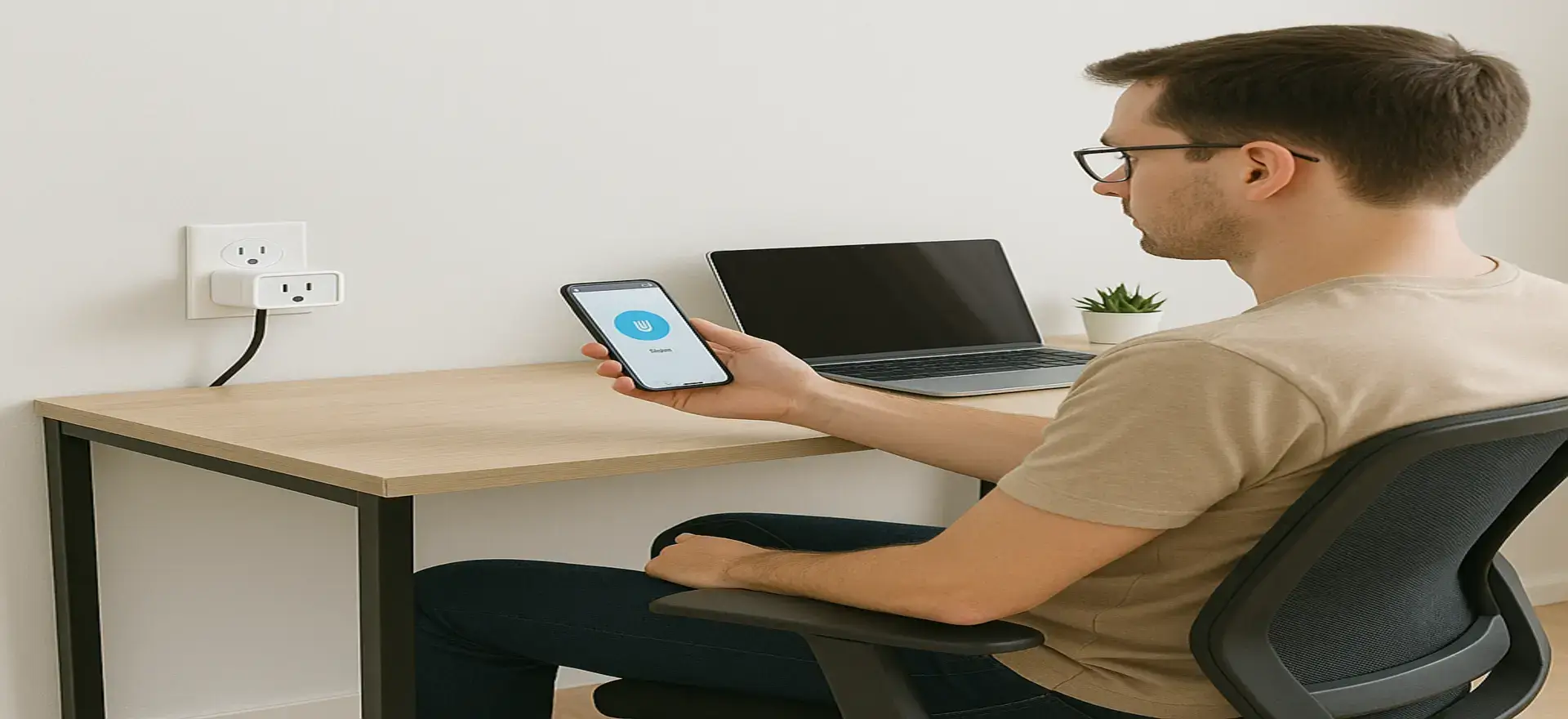
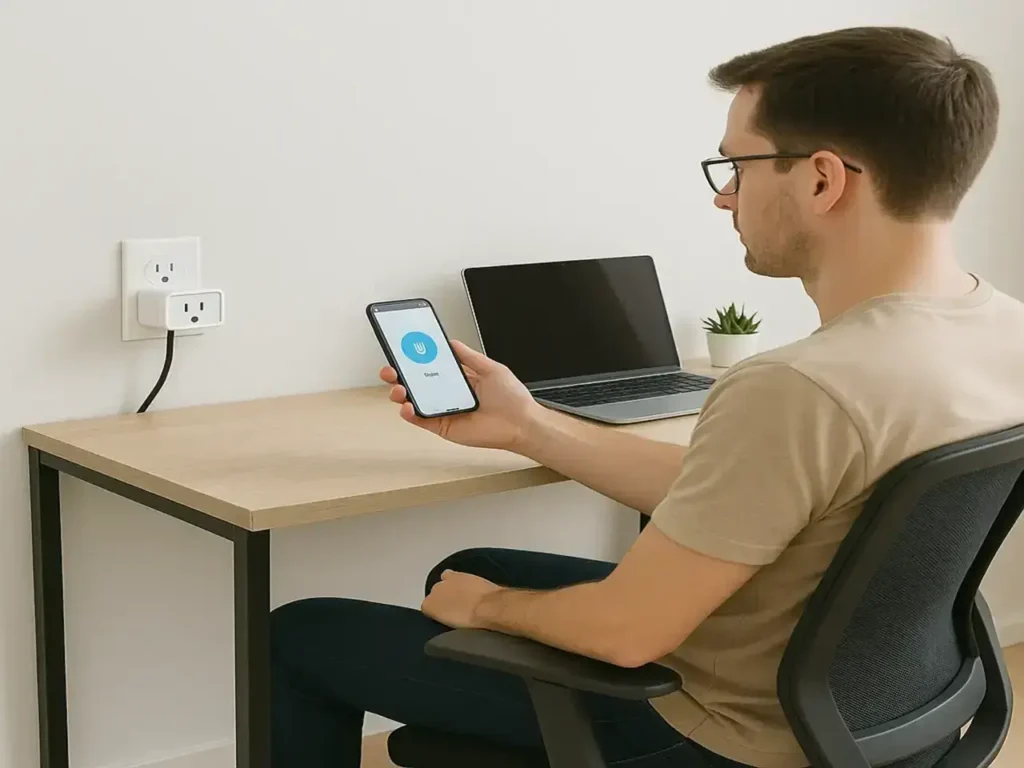
This image has been generated using AI for illustrative purposes only and does not represent an actual product image.
Safety, Privacy, and Your Security Deposit
Stay within 15A/1800W. Check the appliance label. A smart plug isn’t a magic fuse—don’t push heaters or AC beyond spec.
No marks on walls. Because HS103 is add-on only, you’re not touching drywall, junction boxes, or plates; move-out is hassle-free.
Account hygiene: unique password for Kasa; enable two-factor authentication if available.
Pros and Cons (Renter Edition)
Pros
No hub or tools; fully portable.
Mini footprint; rarely blocks the second outlet.
Schedules, Timers, Away Mode, and voice control that “just works.”
Cheapest way to automate a room and prove smart habits “stick.”
Cons
No HomeKit/Matter on HS103 (choose KP125M if you need that).
No energy monitoring (choose KP115 if you want kWh).
2.4 GHz only and dependent on your apartment Wi-Fi quality.
15A/1800W limit—not for heavy appliances.
Who Should Skip the HS103 (Be Honest About Fit)
You’re already deep in Apple Home and want native Home app control for every device → start with KP125M (Matter).
You care about energy insights and plan to optimize bills → the HS103 won’t help; the KP115 will.
You need to control loads that push past 15A → a plug-in module is the wrong product category; consider an appliance with built-in smarts or a landlord-approved hard-wired option.
Buying Tips for Renters (Stretch Your Budget)
Watch for two-packs under the usual street price; they often hit the sweet spot.
Assign plugs to rooms (Bedroom, Entry) rather than device names if you re-arrange often; you can swap what they control without breaking routines.
Keep a tiny note in your moving box listing device names and routine phrases so you recreate your setup in minutes in the new place.
Final Take for Renters
Start with one HS103 where a single routine changes your day—living lamp, desk fan, or the entry light that welcomes you home. Let it run for a week. If you stop reaching for switches and your place feels calmer at night, grab a two-pack and cover the next two chokepoints. For Apple users or mixed households, add a KP125M next; for budgeters tracking usage, add a KP115. If you’re building a smart home for renters you can pack and rebuild in minutes, this is the right first step: small price, daily payoff, no-hassle move-outs.
Related posts:
- What Nobody Tells You About the Ring Battery Doorbell Plus (for Renters) What Nobody Tells You About the Ring Battery Doorbell Plus...
- Why You Need a Govee Water Leak Detector Under Your Sink (A Renter’s Guide) Why You Need a Govee Water Leak Detector Under Your...
- Philips Hue A19 Review for Renters (2025): Still Worth the Hype? Philips Hue A19 Review for Renters (2025): Still Worth the...
- amazon echo dot: the ideal gadget for renters (2025 amazon echo dot: the ideal gadget for renters (2025) by...


